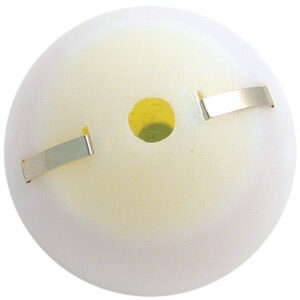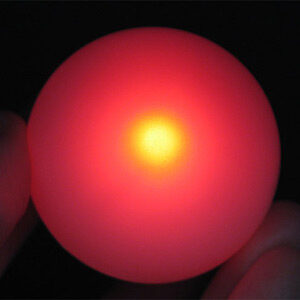 by: Sarah Brandt
by: Sarah Brandt
The uniquely entertaining energy ball is a fun way to demonstrate open and closed circuits, as well for prompting discussions on conductivity. The following activities are perfect to use in elementary and middle school grades first exploring electricity and circuits.
When both sensors on the ball are touched and a complete circuit is formed, the ball flashes a red light and buzzes.
What makes the energy ball work?
Inside the energy ball is a simple circuit that is completely self-contained. By touching both sensors, the circuit is completed by electrons flowing through your body or another conductive material such as a paper clip. Materials that activate the energy ball
are good conductors, meaning they pass electrons easily. Materials that do not activate the energy ball are poor conductors (or insulators), meaning they do not pass electrons easily. Your students will enjoy finding different ways to activate the ball:
One Student: Simply hold the ball so that both sensors are touched or, press one sensor with your hand and the other with a paperclip. Try experimenting with other materials (cardboard, plastic, metal) to see which will activate the ball.
Multiple Students: Using two students, have each student touch a sensor, and then hold hands with one another. See how many students can hold hands and still keep the energy ball buzzing. This is an easy way to demonstrate the difference between open and closed circuits – designate one student to be the “switch.” If the switch releases one or both of the hands they’re holding, the ball will stop flashing, representing an open circuit. Holding hands again will resume flashing, and the circuit will be closed.
An Entire Class: For a fun teaching game, try playing a variation of “Duck, Duck, Goose,” with the energy ball. First, form a circle of hands with the energy ball between two students. One student should be outside the circle, who will be “it.” This student should then go around the circle, pointing to each person in turn and saying either “closed” or “open.” Once a person has been designated “open,” he or she should break the circuit and try to make it around the circle and complete the circuit before the person who was “it”.
Educational Innovations sells the Energy Ball (SS-30) for $3.95.


[…] you’re interested, here’s another blog post on the Energy Ball with useful lesson […]
Are they available in Ontario Canada
They absolutely are! Just go to our website http://www.teachersource.com to purchase them.
We are thinking about to break a guinnes record. How many people can be in the chain? I guess that will be a critic number.
Thnaks a lot